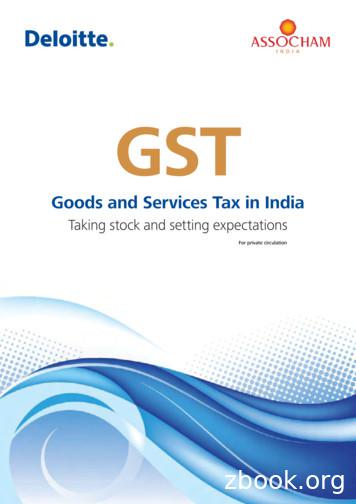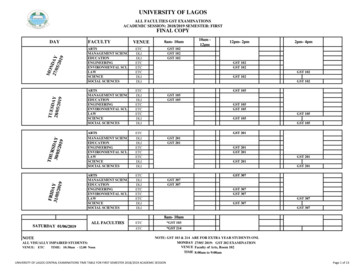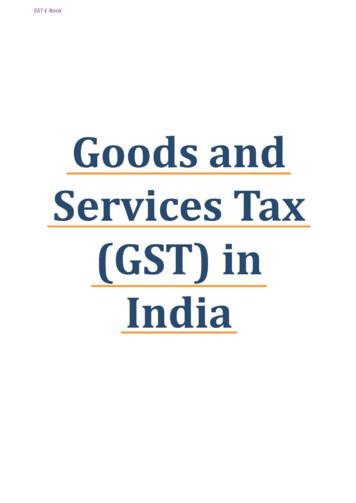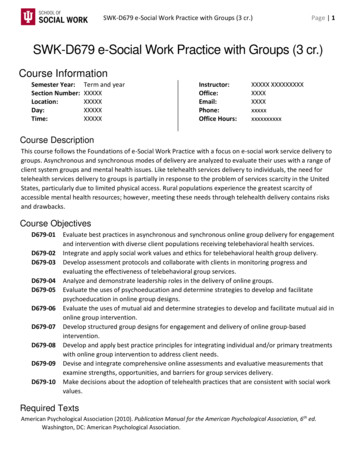GST - Audit, Consulting, Advisory, And Tax Services
GSTGoods and Services Tax in IndiaTaking stock and setting expectationsFor private circulationSecond line optional lorem ipsumB Subhead lorem ipsum, date quatueriure
FOREWORDASSOCHAM has been undertaking various studies on issues of topical interests fromtime to time and facilitate Government, policy makers, opinion makers and theinvestors in formulating the policies. We took an early lead in facilitating introductionof Value Added Tax (VAT) by organizing over 40 conferences all over the countryand produced 7 expert papers extensively disseminated amongst the policy makers,Parliamentarians, Legislatures, Centre & State Governments and other stakeholders.The then Finance Minister Shri P Chidambaram had greatly appreciated ASSOCHAMContribution in this regard.Similarly in the case of GST, ASSOCHAM brought out 6 study papers on GST and has sofar organized 40 Conferences with the support of the Ministry of Finance covering notonly the major cities but also 2 tier cities as well. Our contribution was acknowledgedby the then Finance Minister Shri Pranab Mukherjee during his interaction with theIndustry leaders at Vigyan Bhawan in 2011.We are happy to present to the Government & the other stake holders theASSOCHAM’s 7th Study paper on Goods & Service Tax (GST). We would speciallylike to thank and appreciate the initiative of Deloitte, our Partner for this study paperwithout whose intellectual support; it would not have been possible to come outwith this Report. We hope this will be useful, informative and will create conduciveenvironment for the introduction of Goods & Service Tax at the earliest.We shall welcome any comments / suggestions on the Report.D.S. RawatSecretary General
ContentsGlobal Value Added Tax (VAT)/ Goods and Service Tax (GST) Trends2Proposed GST Structure for India6Key Concepts under Proposed GST structure for India11Role of Goods and Services Tax Network (GSTN)17Summary of expectations from proposed GST regime in India20About Deloitte23About ASSOCHAM24Goods and Services Tax (GST) in India Taking stock and setting expectations1
Global Value Added Tax (VAT)/Goods and Service Tax (GST)TrendsThe spread of Value Added Tax (VAT) or Goods and Services Tax (GST) system of Indirect taxes across the globe isshowing an increasing trend with more than 160 countries, including 33 of the 34 member countries of Organizationfor Economic Co-operation and Development (OECD), employing VAT as the preferred form of consumption tax1(refer Graph 1 below). Malaysia is the recent country to implement GST effective 1 April 2015 and current Indiangovernment has announced a timeline to introduce GST in India by 1 April 2016.Countries introduced VAT/GST for different reasons depending on their existing tax system and in case of EuropeanUnion (EU) to replace turnover taxes on account of the ease of handling cross border-transactions, facilitatingdevelopment of common market and reducing trade and economic distortions. Another reason of countriesadopting VAT/GST was to increase revenue from general consumption to cut down rate of income taxes. Revenueneutral approach was another reason (Norway, New Zealand etc.). Other counties moved to VAT/GST to consolidateand modernize existing tax structure comprising of multiple sales tax at different rates.This increasing trend towards VAT/GST can be attributed to key factors such as1. VAT/GST preserves neutrality by taxing the value added by each factor equally;2. Consumption tax is large and more stable source of revenue; and3. Potentially self-enforcing in nature.Graph 1: Increase in the VAT/GST 0720082009201020112012201320140Source: OECD report on Countries with VAT 1960-2014As economists, Richard M. Bird & Pierre-Pascal Gendron noted in their book2, IMF played a key role in this spreadby consistently supporting and advocating this form of taxation and facilitating its adoption by countries with lessdeveloped economic and administrative structures as well. OECD has also launched a project to develop InternationalVAT/GST Guidelines to apply VAT to cross border trade, with an aim to reduce uncertainty and risks of doubletaxation and unintended non-taxation that result from inconsistencies and the third meeting of the OECD GlobalForum on VAT is scheduled to be held in Paris in November 2015.122OECD (2014), Consumption Tax Trends 2014, OECD Publishing; http://dx.doi.org/10.1787/ctt-2014-enThe VAT in Developing and Transitional Countries role of International Monetary Fund (‘IMF’) in spreading VAT to developing countries
A roundup of VAT/GST structure of some of the major economies and taking stock as to rate of tax, threshold limits,exemptions, zero-rated transactions etc. would provide a guidance and allow legislators of jurisdictions, planning tointroduce new tax regime or replace existing structure with revised structure, to learn from other consumption taxsystems and adopt the best practice in laying the groundwork.European Union (EU)European Economic Community adopted VAT throughout Europe, replacing cascading multi-stage turnover tax,owing to the ease with which it handled cross-border transactions and facilitated development of a common market.Council Directive 2006/112/EC adopted in 2007 (‘VAT Directives’) codifies the provisions implementing the commonsystem of VAT and Council Regulation (EU) No 282/2011(VAT Implementing Regulation) lays down bindingimplementing measures to ensure uniform application of the VAT Directive. The VAT Directive sets the frameworkfor the VAT structure in the EU, but it gives national governments freedom to set the number and level of rates theychoose and transport provisions of VAT Directives into national legislation, subject to below basic rules: Supply of all goods and services in the course of business by a taxable person within EU is subject to VAT at a standardrate not lower than 15%3, unless specifically exempt. EU member states can opt to apply one or two reducedrates not less than 5%4 for supplies of goods or services, such as foodstuff, water supplies, pharmaceutical, books,admission to cultural/amusement/sporting services, social services, medical services and equipments, agriculturalinputs etc., listed in Annex III of the VAT Directive. Member states may continue to charge any lower rates, includingzero rates, which were in place on 1 January 1991, though they cannot introduce any new rate under 5%. Activities and supplies in public interest, such as medical care, services linked to welfare and social security work bypublic entities or charitable organizations, certain education and cultural services; specific financial and insuranceservices; certain supplies of land and buildings; export of goods, intra-EU supplies etc.5 are exempt from VAT.CanadaIn Canada, GST is applicable on supply of most goods and services including real property and intangible personalproperty and is governed by Excise Tax Act. Canada has a federal government (like in India) and a federal GSTwas introduced in 1991 replacing the existing federal sales tax imposed on manufacturers and certain licensedwholesalers at a general rate of 13.5%. However, all provinces continued with the provincial retail sales tax (‘PST’)thereby having two levels of levy. The harmonized sales tax (HST) is imposed in provinces that have harmonized theirprovincial sales tax with the GST (New Brunswick, Nova Scotia, Newfoundland and Labrador, Ontario, Prince EdwardIsland) and is a combination of a federal component and a provincial component (i.e., 5 percent to 8 percent)applicable generally on same base of property and services as the GST. In the remaining provinces, GST is imposedon taxable goods and services alongwith provincial sales tax or a retail sales tax. The three territorities (NorthwestTerritorities, Nunavut and Yukon and Province of Alberta charge GST at the rate of 5%.Most goods and services supplied in or imported into Canada are taxable supplies and are subject to GST at the rateof 5% or HST in the range of 13% to 15% (federal component of 5% and provincial component of 8 to 10%) withcertain exceptions based on policy decisions such as: Exports and supplies of goods and services relating to basic needs of individuals such as drugs and biologicals,medical and assistive devices, basic groceries, agriculture and fishing, transportation and travel etc. are taxed at therate of 0% (zero-rated)6. Supplies of goods and services supporting public needs such as certain real property, healthcare, educational, child andpersonal care, legal aid, public sector bodies, financial services, ferry/road/bridge tolls etc. are exempted from GST/HST7.34567Article 96 and Article 97 of VAT Directives. As per Council Directive 2010/88/EU dated 7 December 2010, standard rate shall be not lowerthan 15% until 31 December 2015Article 98 (1), Article 98 (2) and Article 99 of VAT DirectivesArticle 132 to Article 153 of VAT DirectivesSchedule VI [Subsection 123(1)] of Excise Tax ActSchedule V [Subsection 123(1)] of Excise Tax ActGoods and Services Tax (GST) in India Taking stock and setting expectations3
New ZealandThe New Zealand GST, enacted in 1988, was designed as a comprehensive tax base including many difficult-to-taxgoods and services. The New Zealand GST become an international benchmark for indirect tax design, for instance,the Institute of Fiscal Studies of United Kingdom, considered the New Zealand GST model as the benchmark forevaluation of the European VAT Directives8.In New Zealand, GST governed by GST Act, 1985 is applicable on most indigenous goods and services, mostimported goods, and certain specified imported services at a rate of 15%9. Goods includes all types of personal and real property except actionable claims, money and products transmittedby a non-resident to a resident by means of wire, cable, radio etc. and by other such technical systems. Servicescovers everything other than goods or money. Supply of certain goods and services such as exported goods and services, telecommunication services, supplieris a territorial authority and the consideration for the supply is proceeds from the local authorities, sales of goingconcern (slump sale), sale of land etc. are subject to GST at the rate of 0%10. Supply of certain goods and services such as private property (car or home not used for business), financial servicessuch as interest payment on loan or bank fees, donated products and services sold by not-for-profit organization,rental on residential property, penalty interest etc. are exempt11 from GST.AustraliaImplementation of New Tax System package in Australia including New Tax System (Goods and Services Tax) Act,1999 is considered as a landmark change to the Australian tax system. The new GST replaced the federal wholesalesales tax and some state and territory taxes with a single tax rate of 10% tax on supply of most goods and serviceswith some exceptions. The basic rule of GST in Australia is destination-based consumption tax with limited tax base exclusions. Certain supplies such as certain food products, most medical and health services, drugs, medical aids andappliances, most education courses, child care, exports, religious services, international transport etc. are known asGST-free12 on which GST not payable (other counties refer to these as zero-rated). Certain supplies such as financial supplies, residential rent, residential premises, precious metals, school tuckshopsand canteens and fund raising events conducted by charities etc. are known as input-taxed supplies13 (othercountries refer to these as exempt) and no GST is applicable on such supplies.89101112134Popularly known as Mirrlees Review led by economists James Alexander Mirrlees cited by Richard Krever and David White in their book ‘GSTin Retrospect and Prospect’Section 8 (1) of GST Act, 1985Section 11, 11 A, 11B, 11 AB, of GST Act, 1985Section 14 of GST Act, 1985Division 38 of New Tax System (Goods and Services Tax) Act, 1999Division 40 of New Tax System (Goods and Services Tax) Act, 1999
Graph 2 below summaries VAT/GST rates and threshold limits applicable to above discussed jurisdictions:Graph 2: VAT/GST Rates And Threshold Limit - 2015Peak Rate (%)General Threshold (USD)High Peak Rate (High): 27%30120,00025100,0002080,0001560,000EU Peak Rate (Low): 17%1040,000AustraliaNew ZealandCanadaSwedenUnited KingdomSpainSloveniaSlovak eGermanyFinlandFranceEstoniaCroatiaDenmarkCzech Republic0Belgium0Austria20,000Bulgaria51973 1994 1971 1993 1967 1998 1991 1968 1994 1968 1987 1988 1972 1973 1992 1995 1994 1999 1970 1969 1993 1986 1999 1993 1999 1986 1969 1973 1991 1986 2000Year of ImplementationGeneral Threshold (USD)***Peak Rate (%)Source: OECD and European Commission report on VAT/GST rates and threshold applicable in member countriesObservations From VAT /GST In Other JurisdictionsReview of the VAT/GST legislations and provisions prevailing in the above mentioned jurisdictions, a similar trendhas been observed in terms of the underlying principles. VAT/GST being destination based and therefore applicableon consumption that takes place in the respective country/region and therefore exempts exports and taxes imports.Further, input tax credit can be claimed for the cost of procuring and producing in case of zero-rated supplies andcannot be claimed in case of exempted supplies.VAT/GST reform has proved to be a robust source of tax revenue in all jurisdictions. Notwithstanding that VAT/GSThas emerged successful and supreme over the other forms of indirect taxation, these jurisdictions are continuouslyworking towards reforming structural issues such as in December 201014, European Commission published a GreenPaper on the future of VAT and argued that there were “numerous shortcomings in the current VAT system whichcreate obstacles to the Internal Market, cause burdens for businesses and prevent Member States from benefittingfrom the true potential of this tax” and also pointed out the system is susceptible to fraud. Businesses are reported tofind VAT model in European Union very complicated on account of huge diversity in application of exemptions andreduced rates among member states causing distortion in competitiveness and additional compliance costs (reportedto be around 11%15) borne by businesses that conduct cross-border trade when compared to those businesses thatonly trade domestically. In Canada, businesses are reported to be facing challenges under GST/HST on account ofinterpretation issues and multiple provinces having variety of tax rates. British Columbia, though harmonized itsPST with the GST in July 2010 re-implemented PST in 2013. Like in all other jurisdictions, even in New Zealand andAustralia the compliance cost under VAT/GST has been reported to be relatively more burdensome for small sizebusiness entities.1415Green Paper: On the Future of VAT, COM (2010) 695 final, 1 December 2010. Responses to the Green Paper were invited by 31 May 2011European Commission: Feasibility and economic evaluation study; AXUD/2013/DE/319 dated 30 June 2015Goods and Services Tax (GST) in India Taking stock and setting expectations5
Proposed GST Structurefor IndiaIn India, GST was conceived in 2004 by the Task Force on implementation of the Fiscal Responsibility and BudgetManagement Act, 200316 (Kelkar Committee) while analyzing prevailing indirect tax system both at Central and Statelevel. The Kelkar Committee observed that a tax reform of nationwide dual GST which would comprehensively taxthe consumption of almost all goods and services in the economy would be able to achieve ‘a common market,widen the tax base, improve the revenue productivity of domestic indirect taxes and enhance welfare throughefficient resource allocation’.The existing Indian Indirect tax structure empowers levy of taxes by Central government on manufacturing of goodsand supply of services like Customs duties, Central Excise duty, Service tax etc; and State governments on goods atpoint of sale such as state VAT, Entry Tax, Octroi etc. Multiplicity of taxes and tax base being fragmented betweenCentre and States have resulted in a complex system of interconnected legislations leading to substantial distortions,cascading of taxes and adversely effecting growth in Gross Domestic Production (GDP). Some of the limitations of theprevailing Indirect tax structure are: Central Value Added Tax (CENVAT) structure does not tax value addition post the stage of production, CENVAT portion of input goods remains included in the value of goods to be taxed under State VAT contributing tothat extent a cascading effect on account of CENVAT element. No integration of VAT on input goods with service tax on services at the State level thereby causing cascadingeffect of service tax.The proposed GST is consumption type VAT where only final consumption is treated as the final use of a good. GSTis expected to integrate taxes on goods and services across all supply chain for availing set-off and capture valueaddition at each stage. A continuous chain of set-off is expected to be established from the original producer's/service provider's level upto the retailer's level which would eliminate the burden of all cascading effects. Suppliers ateach stage would be permitted to set-off the GST paid on the purchase of input goods and services against GST tobe paid on the supply of goods and services.GST Model Proposed for IndiaBased on the recommendations, the Government constituted an Empowered Committee comprising of State FinanceMinisters (Empowered Committee) to prepare a Design and Road Map for the implementation of GST.Salient features of the proposed GST model based on reports of Empowered Committee are summarized below:1. Aligned with the federal structure of the Indian government, GST model is proposed to be a dual structure (likein Canada) to be levied and collected by the Union government [referred to as Central GST (CGST)] and respectiveState governments [referred to as State GST (SGST)]. This dual GST model would be implemented and governedby one CGST/IGST statute applicable across the country, SGST statutes for each State, common rules determiningvaluation, place of supply, place of origin etc. This would imply that the Centre and the States would haveconcurrent jurisdiction for the entire value chain and the basic principles of law such as chargeability, definitionof taxable event and taxable person, measure of levy including valuation provisions, basis of classification, etc.shall be uniform across State statutes. It has been reported that draft laws are already ready and under internaldiscussions. Also, various allied rules are in the process of being drafted and finalized.2. CGST and SGST would be comprehensively applicable to all goods and services upto the final consumer (retaillevel), reflecting the tax base of a typical consumption VAT. Thus, CGST and SGST would be applicable to all166Headed by Dr. Vijay L. Kelkar published its report on July 2004
transactions involving supply of goods and services made for a consideration (except alcoholic liquor for humanconsumption) and the exempted goods and services, goods which are outside the purview of GST and thetransactions which are below the prescribed threshold limits. Based on recommendations of both the 13thFinance Commission and Empowered Committee, GST on following products shall be levied from a date to benotified by the GST Council Petroleum Crude High Speed Diesel Motor Spirit (commonly known as Petrol) Natural Gas Aviation Turbine Fuel3. GST to be structured on the destinatio
Contents Global Value Added Tax (VAT)/ Goods and Service Tax (GST) Trends 2 Proposed GST Structure for India 6 Key Concepts under Proposed GST structure for India 11 Role of Goods and Services Tax Network (GSTN) 17 Summary of expectations from proposed GST regime in India 20 About Deloitte 23 About ASSOCHAM 24 Goods and Services Tax (GST) in India Taking stock and setting expectations 1
gst 201 8am- 10am gst 102 gst 102 gst 102 gst 105 gst 105 gst 105 12pm- 2pm gst 102 gst 102 gst 102 gst 105 gst 105 gst 105 y 9 arts management sciences education engineering environmental sci. law law science social sciences arts day faculty science social sciences arts management sciences
3. Implementation of GST And Acts of GST 4. Whom to Register under GST 5. Who is Exempted from Register under GST 6. GST Composition Scheme 7. Invoice and Its Format under GST 8. Bill of Supply and Its Format under GST 9. E – Way Bill under GST 10. Time of Supply under GST 11. Place of Supply of Goods
Budgeted balance sheet This budget is prepared using the asset, liability and owner’s equity accounts. If GST payable (on GST collected) is GST input tax credits (on GST paid), the net GST payable is shown as a current liability. If GST payable (on GST collected) is GST input tax credits (on GST paid), the net GST input tax
(Malaysia) BL 6 % Purchases with GST incurred but not claimable (Disallowance of Input Tax) (e.g. medical expenses for staff). GST Goods And Services Tax (Malaysia) NR 0% Purchase from non GST-registered supplier with no GST incurred. GST Goods And Services Tax (Malaysia) ZP 0% Purchase from GST-registered
GST For Jewellers Frequently Asked Questions . 2 1. What is GST? Ans- GST is an indirect tax which will eliminate various taxes like VAT tax, Excise, Service tax, Octroi, etc. 2. From when will be GST implemented? Ans- GST is likely to be implemented from 1st July 2017. 3. Is income tax required to be paid after GST? .
GsT – COmpleTInG yOur ACTIvITy sTATemenT 5 01 TermS We uSe When we say: n sales, we are referring to the GST term supplies n purchases, we are referring to the GST term acquisitions n GST credits, we are referring to the GST term input tax credits n reporting period, we are referring to the GST term tax period
Advantages and Disadvantages . (in GST) Activation of GST in Tally GST Purchase Invoice Creating GST Sales Invoice GST Tax Ledgers GST Invoices of Trading Organization Printing Invoice in Tally . discounting, stock valuation methodology, etc. Tally accounting software also comes wit
3. Wenger-Clemons, J. (2014). Client system assessment tools for social work practice (Canvas). Group Assignment s . 1. Therapeutic Group Work Assignment 2. Therapeutic Group Work Twitter Feed Individual Assignment 1. M2 Quiz . Module 3: Identity-Based Social Action Group Work . Weeks 5 and 6 . Overview . A. This module reviews a number of topics around how we construct self-concepts and self .


















